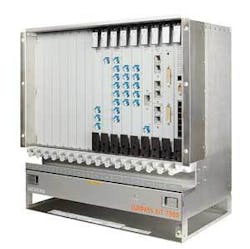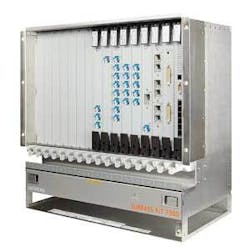Siemens unveils ‘multihaul’ transport system
Looking to expand its success in the long-haul market to other applications, Siemens Communications Inc. (www.siemens.com) has developed the SURPASS hiT 7300 optical transport platform. The company describes the system as “multihaul,” which means it can be configured for metro, regional, long-haul, and ultralong-haul applications. A high degree of automation decreases the amount of work and time required to provision new links and new services, the company says.
According to Susan Schramm, vice president of marketing within the Networks Division of Siemens Communications, increasing bandwidth demands have taxed metro and regional networks to the point where DWDM and reconfigurable optical add/drop multiplexing (ROADM) technologies have begun to make sense from an operational standpoint. However, most of these systems, built for the long haul, do not meet the requirements for comparatively low cost, flexibility, and robustness that metro and regional networks require. The SURPASS hiT 7300 offers an alternative to such currently fielded systems, providing the performance of the company’s SURPASS hiT 7500 equipment in configurations that better meet the needs of metro and regional infrastructures.In particular, Siemens has designed the platform to be easy to use and flexible in terms of deployment, automation, and configurability. A wavelength-routing planning tool means that a service provider can bring up a new link by “touching” only the two end points, then handling the routing between those two points in the network operations center. G.709 support enables end-to-end management and performance monitoring for all services, enabling SONET/SDH-like service-level agreements. The planning software and element management system are tightly integrated, according to Alan Gibbemeyer, director of the Next Generation Business Unit within the Networks Division. The system is designed to enable services that used to take days to provision to be up and running in a matter of hours, he says. Use of the SURPASS hiT 7300 can cut the cost of provisioning by as much as 60% or more, Siemens’s research has revealed.
The system also is very scalable, capable of eight-channel CWDM operation to the support of 40 channels in its initial configuration and 80 channels in the future. It also accommodates a range of interfaces, from 2.5 to 40 Gbits/sec, and reach of 1,800 km without electrical regeneration. In addition to SONET/SDH, the system supports Gigabit Ethernet, 10-Gbit Ethernet LAN and WAN PHY, and Fibre Channel services. It also supports a variety of networking architectures, including point-to-point and mesh topologies, and offers photonic crossconnect capabilities.
Other vendors have espoused the multihaul concept, in which a single, flexible platform can be used almost anywhere in the network, depending upon how it has been configured. Movaz Networks, before ADVA Optical Networking (www.advaoptical.com) acquired it, described such an approach in this magazine earlier this year (see “Multihaul DWDM Networks Emerge,” June 2006, page 1). While ADVA Optical Networking and Siemens have worked together to extend the latter’s product line in the past, Gibbemeyer says Siemens developed the SURPASS hiT 7300 completely in-house.
The types of potential customers for the system appear almost as varied as the applications for which the transport platform can be configured. In addition to interexchange carriers, Gibbemeyer says that mobile operators looking for backhaul options, cable multiple systems operators, and large enterprises represent viable markets. The system is already in general availability and Siemens is shipping the product to five “major customers.” Gibbemeyer declined to identify who they are, although he did reveal that they are spread throughout the world, including South America.
With the system’s top-end capabilities nearing that of the existing hiT 7500, it might appear that Siemens faces the threat of cannibalizing some of its existing business with the new system. Gibbemeyer admits that there is some overlap between the applications for the two systems, but points out that the hiT 7500 is purpose-built for the long-haul and ultralong-haul market segments and much of the demand for the hiT 7300 will come from metro and regional requirements.
